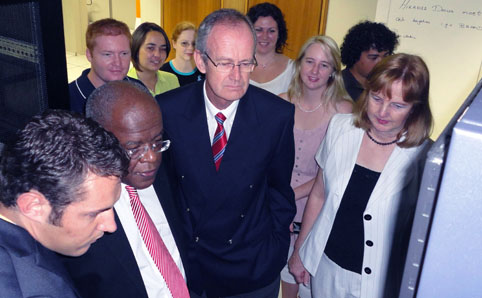 |
|
Prof. Jonathan Jansen, Prof. Theuns Verschoor and staff of the UFS ICT department at the unveiling of the HPC cluster
|
Our university has unveiled a brand-new multimillion-rand High Performance Computing (HPC) cluster, which promises to enhance the way research is done at our university.
The new HPC cluster is a super powerful computing cluster, and already has 28 users from six university departments using it to speed up and simplify their research. The cluster of more than R2,7 million was unveiled in March 2011.
It boasts an incredible 800 processing cores and special high-speed data-transfer technology, to make even the most expensive home PC look like a stone-age relic.
Prof. Janse Tolmie, Senior Director: Information and Communication Technology Services (ICT Services) at the UFS, says the cluster is used to simulate experiments and their outcome electronically, using advanced software and the high processing power of the cluster.
The cluster is especially useful to researchers in the Chemistry, Bio-chemistry and Medical Physics departments. Prof. Tolmie says these simulations are an internationally recognised means of conducting research and it is very important for a research institution to have access to such a facility.
In the past, many research articles have been published by UFS researchers, based on research done using the previous incarnation of an HPC cluster at our university.
Prof. Tolmie says the cluster can also be connected to clusters at other universities and research facilities to form national or international HPC grids.
This will enable researchers elsewhere to access the massive processing power that UFS researchers now have at their fingertips.
Media Release
30 March 2011
Issued by: Lacea Loader
Director: Strategic Communication
Tel: 051 401 2584
Cell: 083 645 2454
E-mail:
news@ufs.ac.za